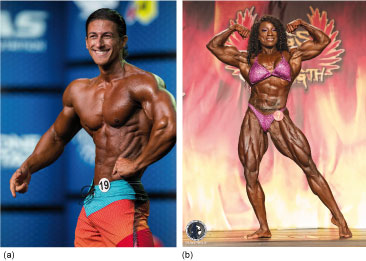6 Gender outlaws
In the previous sections you explored hegemonic masculinity and femininity and how men and women who challenge these through sport can be considered as outsiders, or what Shilling and Bunsell (2009) describe as ‘outlaws’. One of the most notable examples of women being referred to as ‘outlaws’ is female bodybuilders. In the next activity you will explore how female bodybuilders challenge the perceived gender norm.
Activity 6 Female bodybuilders

Look at the photos above of a male and a female bodybuilder. Note your immediate reaction to these two photos.
Reflect on why you reacted the way you did to the images and consider whether your reaction was influenced by stereotypical perceptions of femininity and masculinity. Were your reactions indicative of gender discrimination?
Discussion
Numerous authors (e.g. Roussel et al., 2003; Shilling and Bunsell, 2009, 2014) have suggested that female bodybuilders challenge the gender norm by seeking a muscular body, which is generally viewed as more acceptable for men. Do you believe that this is true (think about your immediate reaction)? Think about whether and how different your responses were to the two images and whether you think this was because of gender.
Shilling and Bunsell (2009) refer to female bodybuilders as ‘gender outlaws’ because they break gender norms, both aesthetically (appearance) and kinaesthetically (touch), of what it means to be a woman. When these photos have been shown to students in the past there has been a much stronger reaction to the appearance of the female bodybuilder than to the male bodybuilder. I hear students respond with comments such as ‘Urgh, gross!’ or ‘It’s just wrong for women to look that muscular’ or ‘I don’t think women or men should be that muscular’.
The activity you have just completed, along with the rest of this course, will have encouraged you to reflect on gender perceptions within society and how these impact on sport, with a particular focus on the question ‘Does gender discrimination exist in sport?’ The ability to evaluate the evidence before reaching an answer to a question like this is a very important skill.
